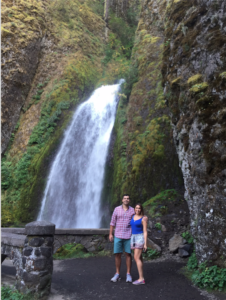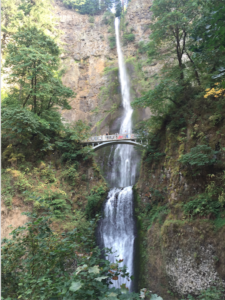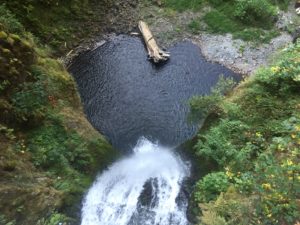My Adventures in Stone Portland, Oregon edition continues at Wahkeena Falls and Multnomah Falls. These amazing waterfalls are breathtaking and have such an amazing geological history.

I took the quick hike up Wahkeena Falls and found myself gazing upon the source of the waterfall. As the fresh cool water splashed my face, I couldn’t help but admire the amazing rock formations surrounding the gushing water.
First, some quick facts about Wahkeena Falls:
The Wahkeena Trail climbs up to 900 feet and looks onto an amazing view of the Columbia River.
The 242 foot falls were once called Gordon Falls in honor of pioneer land owner, F.E. Gordon. However, in 1915, a committee of the Mazamas changed the name of the creek and falls to Wahkeena, the Yakima Indian word for “most beautiful.”
The rocky terrain consists of cliffs and talus. Talus is formed by the erosive action of ice on the exposed bedrock cliffs which dislodges rocks. The broken rocks fall to form sloping piles of debris. As this process continues, cliffs grow steeper and talus piles deeper. Plants and animals find homes in the nooks between fallen rocks and ledges. Cute little animals such as the Pika (members of the rabbit family) live in these alcoves.

A quick car ride down the street brought us to Multnomah Falls. This striking waterfall is so tall with a picturesque bridge constructed halfway up. The air feels cooler as the water quickly flows down. It’s hard to imagine that the falls were formed by molten lava.
According to the Multnomah Falls information center, millions of years ago, massive floods of molten basalt (some of the largest lava flows on Earth) poured over present-day northeast Oregon, southwest Washington and western Idaho.
More than 300 individual lava flows covered Eastern Washington in more than 5,000 feet of basalt. This lava formed the Columbia River Plateau layer by layer. Later, as the Missoula Floods surged through the Columbia River Gorge, the water exposed layers of basalt in its steep cliffs. There are three types of basalt that have been discovered: Entablature Basalt, Pillow Basalt and Columnar Basalt.
As the water constantly flows from Multnomah Falls, the water erodes softer layers of rock below and behind the falls, creating a plunge pool and cave.

The upper falls recede faster than the lower falls due to the type of rock. Occasionally, as ice freezes and thaws, the rocks wedge apart. Large chunks of basalt rocks have broken off and fallen to the pool below. This constant geologic process will continue to sculpt and change the Portland geography.
